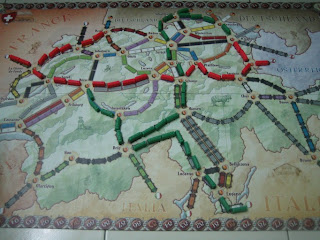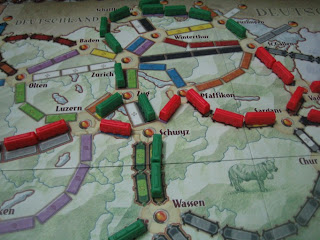I bought many games in December. I bought some at the Fantasy Flight Games (a game publisher) end-of-year sale, and some from Troll & Toad, an online retailer, which also had a special sale in December. I bought seven Blue Moon (a card game) expansions, Ticket To Ride Switzerland (an expansion), Thebes, Carcassonne Abbey and Mayor (another expansion), Power Grid Deck 2 (a small expansion - just a deck of cards), Axis & Allies Guadalcanal and In the Year of the Dragon. Since I was back in Sabah, I asked for the games to be shipped to Han, and on Sat 5 Jan 2008 he brought them to me during our boardgame session.
Ticket To Ride is a game which took me a long time, and many plays, to warm up to, although it is one of Michelle's favourites. I decided to get Ticket To Ride Switzerland because it is designed specifically for 2 or 3 players. (well, I may get it anyway even if I did not have this excuse to use) There are some minor tweaks to the rules of the basic game, e.g. the tunnels (same as Ticket To Ride Europe) where you need to draw 3 random cards from the deck, and if any matches the colour you are playing, you must top up additional cards. You are now allowed to take two face-up jokers (locomotives cards), but jokers can only be used for tunnels. So, it can be very painful to try to collect cards of a specific colour for a long, normal, non-tunnel route. There are some city-to-country and country-to-country tickets. They give you options. If you complete a route to a further country, then you score higher points; closer country, lower points. In case you cannot complete the ticket at all, i.e. unable to connect to any of those countries, you are only penalised the points of the nearest country.



I have played this three times with Michelle now. I enjoy the ticket-drawing aspect of it. According to the designer Alan Moon, this expansion was designed so that people can draw many tickets, which is an aspect he likes. Maybe because the map is smaller compared to other versions, you can usually find at least one not-too-difficult-to-complete ticket when you decide to draw tickets (you also draw 3, like in the base game). Many people commented that in this expansion you can get blocked or cut off very easily. Michelle and I didn't find this to be the case. There were some blocking, but they were not too bad. Maybe for two players it is not too bad, and it only gets worse with 3 players. I find that playing Ticket To Ride with the Big Cities variant (which comes with the USA 1910 expansion) has more blocking. In terms of the excitement of getting blocked or cut off, I find that Big Cities is more exciting. Well, maybe we were just lucky in our first 3 games.
Michelle discovered something about the Ticket To Ride series which I have never realised after playing more than 170 games of Ticket To Ride and its various versions. The point value of a ticket is the same as the number of trains of the shortest possible route between the two destinations on that ticket. We checked quite a number of tickets and found that this holds true for all of them. It is quite amazing that we never realised this until now.
I like Ticket To Ride Switzerland. It has its own uniqueness compared to other versions, and I enjoy drawing ticket, and finding I only need to claim just one or two routes to complete the ticket, or sometimes I don't even need to do anything and my existing network already fulfills the ticket. I guess that's a cheapskate mentality where you gain something without putting in any effort. 不劳而获.
Some people complain that now that Days of Wonder (the publisher) is printing games in China, the quality has become much poorer than before. Ticket To Ride Switzerland is one of their first games being printed in China. I can see that the components (the cards and the gameboard, since this expansion only came with these two) are of a different quality compared to previous games. However they are actually still very good. The only thing that is poor is the box insert made of cardboard, but that's a very minor issue for me.
I have not been buying many of the Carcassonne expansions, even though Michelle and I like this game a lot. We just play the base game plus the Inns & Cathedrals expansion. I don't quite fancy the Traders & Builders expansion, having played it a number of times before, so I never bought it. I wasn't interested in the other later expansions like The River, The Count of Carcassonne, Princess & Dragon, Towers of Carcassonne either. I have played other standalone variant versions - Carcassonne The Castle, Carcassonne Hunters and Gatherers (the only one I own), Carcassonne The Discovery, Carcassonne The City, Ark of the Covenant. I guess I can call myself a Carcassonne veteran.
I decided to buy Carcassonne Abbey and Mayor because I read a review commenting that it doesn't change the nature of the game, but rather enhances the existing strategies. One reason I didn't like Traders & Builders so much is the game is starting to get quite "busy" - more and more things to consider, bogging down the game, which I prefer to play briskly.
Carcassonne Abbey and Mayor adds some tiles, and 4 new elements - the abbey, the mayor, the cart, and the barn. The abbey is a tile which everyone starts with in hand, and can only use once in the whole game. It functions as a cloister, but the more important use is to fill "holes", i.e. all four sides enclosed by other tiles. It can help you complete one critical feature, e.g. a large castle, to score big and/or to free up your people who are stuck there because the tile required to complete the feature is rare or does not exist. So, it can be a life saver as well as a game winner.
The mayor is a meeple (which means "my people") with big pants. It can only be placed on castles, and its value is the number of shields in the castle. So it can be very strong in a big castle with many shields, much more so than the fat boy (big meeple) of Inns & Cathedrals. The cart is another meeple, when it completes a feature, it can move to an adjacent incomplete and unoccupied feature. The barn is a super farmer. It can only be placed on a corner of four tiles and that junction must be all grassland. It kicks aways farmers in that farm, allowing them to score as normal (3pt per complete castle). If farmers from other farms are joined to the barn's farm later, those farmers are also kicked away but only scoring 1pt per complete castle. At game end the barn scores 4pt per complete castle. It can be used offensively to kick away your opponents' farmers. It can also be used to benefit yourself. It is the only way farmers can be retrieved, and if you kick away your own farmers, you basically score that farm twice, once for your own farmer and once for the barn.
This expansion was just alright for me. Indeed it didn't change the nature of the game much. The same techniques still apply. There are some additions to make things interesting, but they are not distracting. However, it didn't make me enjoy Carcassonne much more either. I am probably just as happy with the base game plus Inns & Cathedrals. Among these four elements, I rank how much I like them as follows:
- Barn - Adds a little twist to the end game planning and farmer fighting.
- Mayor - I am actually neutral on this, i.e. the two below I don't quite like. It seems to be mostly used defensively on your own castle if you see it grow big and it has many shields.
- Abbey - The game loses some nastiness, because the abbey is there to save you (albeit only once). In one of our games, Michelle built a huge castle, and I played a cathedral into (triple score if castle is completed, zero score otherwise) it. I placed a number of tiles to make it difficult for her to complete that castle. Her abbey tile came to the rescue, scoring her 63pts. Maybe I'm just a sore loser so I blame the abbey for this.
- Cart - Maybe I don't know how to use it well, but it just feels like another meeple. Often I can't use its ability, or even if I use the ability, it doesn't score me big points. Maybe it should be used in a quantity and not quality approach, i.e. use it to score many times, each time very few points, because every time you use it, you are basically getting a "free" meeple placement.
One thing I find is now we have too many meeples. We already have the fat boy from Inns & Cathedrals, now we get 3 more new meeples. We can use our meeples freely without worrying much about running out. Some tension is lost. I guess we can try to play with fewer meeples.
However one thing I did enjoy from this expansion are the new tiles. Some of them are indeed quite interesting, e.g. the road that branches off at a junction without being broken up. So, in summary, I do not dislike this expansion (unlike some other expansions), but I can probably live without it. Well, now that I have mixed it into my Carcassonne game, I probably will just play with it and not bother taking it out.
No comments:
Post a Comment